Are you a Quiet Speculation member?
If not, now is a perfect time to join up! Our powerful tools, breaking-news analysis, and exclusive Discord channel will make sure you stay up to date and ahead of the curve.
With the recent high-profile events of GP Charlotte and GP Copenhagen in the books, along with the corresponding MTGO Modern Festival and MOCS Championship both featuring Modern, Modern players (and grateful writers) have experienced no shortage of tech and storylines to discuss over the past few weeks. Now, the world’s attention turns to Magic Origins and the upcoming Pro Tour in Vancouver, which promises a huge impact to Standard play, but not much in the way of nonrotating formats. While many are disappointed by the apparent lack of Modern “shake-ups” in the new set, I have not been upset. Magic Origins seems like an excellent send-off for our vanishing Core Sets, and besides, I have a Standard Pro Tour to prepare for.
Where does this leave us for Modern though? While I will shortly be focusing all of my attention on testing Limited and Standard for Vancouver, today I thought I would provide some in-depth discussion on my deck of choice for the entirety of this Modern season: Grixis Control. As is customary for my column, we’ll begin by taking a broad look at one aspect of Magic theory, analyze some history examples, and then dive into the deck discussion. Let’s get to it!
[wp_ad_camp_1]
Shifting Roles
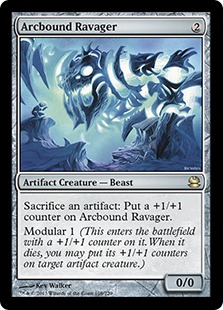 All decks, regardless of tier, classification, or format are built and designed with a specific role in mind. Linear decks are most often aggressive, and are built in such a way to gain the initiative and hold it as long as possible. As we all know by now, these decks are characterized by cheap, efficient threats and general, all-purpose answers. Linear decks operate under the principle that their strategy is constructed in such a way that their threats are cheaper and more numerous than the opponent’s answers, which pushes them into a focused role of aggression as they seek to capitalize on this principle and keep the opponent on the back foot. We see this all the time, regardless of format: White Weenie aggro decks in Standard across time, and most notably Affinity and Zoo decks in current Modern. These strategies have shown time again the power that comes with a large, redundant threat base and the ability to deploy those threats quickly and efficiently.
All decks, regardless of tier, classification, or format are built and designed with a specific role in mind. Linear decks are most often aggressive, and are built in such a way to gain the initiative and hold it as long as possible. As we all know by now, these decks are characterized by cheap, efficient threats and general, all-purpose answers. Linear decks operate under the principle that their strategy is constructed in such a way that their threats are cheaper and more numerous than the opponent’s answers, which pushes them into a focused role of aggression as they seek to capitalize on this principle and keep the opponent on the back foot. We see this all the time, regardless of format: White Weenie aggro decks in Standard across time, and most notably Affinity and Zoo decks in current Modern. These strategies have shown time again the power that comes with a large, redundant threat base and the ability to deploy those threats quickly and efficiently.
On the opposite side of the spectrum, control decks (often) exist as the antithesis to linear strategies. Designed with one goal in mind (stay alive), control decks almost unanimously are characterized by cheap removal to fight early aggression and gain initiative in the early game, general answers (counterspells) to stop a wide array of threats in the midgame, and unbeatable trumps to close the door in the lategame. Control decks are built under the principle that the longer the game goes, the better things get for them.
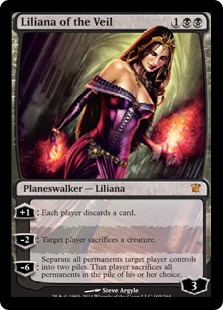 This concept of “shifting roles” is often seen in midrange decks, where the line (and tools available) between linear decks and control decks becomes blurred. Built to be larger and slightly less “focused” than linear strategies without attempting to control every aspect of the game like control decks, midrange strategies often ride the line between both and as a result, contain elements of each. Slower than linear strategies while less powerful than control decks, midrange strategies are often characterized by elements that generate some sort of advantage that can be leveraged against both, be it life, cards, or board presence. Midrange decks more than any other strategy are the most well-equipped to shift roles depending on who they are facing, be they quick, aggressive decks or slow, plodding strategies.
This concept of “shifting roles” is often seen in midrange decks, where the line (and tools available) between linear decks and control decks becomes blurred. Built to be larger and slightly less “focused” than linear strategies without attempting to control every aspect of the game like control decks, midrange strategies often ride the line between both and as a result, contain elements of each. Slower than linear strategies while less powerful than control decks, midrange strategies are often characterized by elements that generate some sort of advantage that can be leveraged against both, be it life, cards, or board presence. Midrange decks more than any other strategy are the most well-equipped to shift roles depending on who they are facing, be they quick, aggressive decks or slow, plodding strategies.
One example of this in practice was Naya Midrange, as many played in the 2013 Standard season.
Naya Midrange, by Eric Rill (SCG Open, Cincinnati 2013)
Built to create a fast board presence and then start generating advantages, Naya relied on the infamous Thragtusk as the lynchpin of its strategy against both aggro and control. The life gain and board presence provided by Thragtusk worked to give linear strategies headaches, while the card advantage generated by free creatures worked to stress control’s answers. It’s no surprise that the oft-maligned Thragtusk was widely considered the best card in the format while it was in Standard; the flexibility offered by an undercosted threat that was strong against both aggressive and controlling strategies defined Standard and exhibited the power of midrange strategies built to adapt to each matchup.
Let’s take a step back for a second. We’ve talked about midrange strategies that are built to shift roles, depending on matchup, and we’ve given a cute refresher on macro-archetypes in Magic. How does this 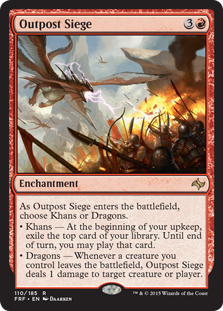 relate to Grixis Control? To begin to answer this, we have to remember one major concept present in all games of Magic: variance. All decks are built with a plan in mind, but often these plans just serve as a framework for how to approach a matchup from a macro-level; everything changes in game. Linear strategies can stumble, or not draw removal for opposing creatures, and need to find some way to “shift roles” in order to find victory. This is why cheap red creatures backed up with burn is such a solid strategy. Red’s burn spells serve dual purpose; removal to clear the way for creatures to keep attacking, and direct damage to close the game out once the enemy has found a way to stop the initial onslaught. Control decks can find themselves suddenly facing a threat that challenges them from a new dimension (Outpost Siege in Standard) and must close the game out quickly before they get grinded out themselves. This is even more relevant in Modern, where strategies are so broad and numerous, and combo is so prevalent, that control strategies can’t hope to answer everything.
relate to Grixis Control? To begin to answer this, we have to remember one major concept present in all games of Magic: variance. All decks are built with a plan in mind, but often these plans just serve as a framework for how to approach a matchup from a macro-level; everything changes in game. Linear strategies can stumble, or not draw removal for opposing creatures, and need to find some way to “shift roles” in order to find victory. This is why cheap red creatures backed up with burn is such a solid strategy. Red’s burn spells serve dual purpose; removal to clear the way for creatures to keep attacking, and direct damage to close the game out once the enemy has found a way to stop the initial onslaught. Control decks can find themselves suddenly facing a threat that challenges them from a new dimension (Outpost Siege in Standard) and must close the game out quickly before they get grinded out themselves. This is even more relevant in Modern, where strategies are so broad and numerous, and combo is so prevalent, that control strategies can’t hope to answer everything.
Roles and Grixis Control
One of my favorite color combinations in Magic is blue-white-red, or Jeskai. Jeskai Control exists as a tier 2 deck (in my opinion) in Modern, and seeks to control the game with plentiful, cheap removal spells and card advantage until the point that it wins through sheer inevitability or manlands. Where Jeskai Control suffers is its inability to shift roles, or “turn the corner”. Against a mana-deprived opponent, Jeskai can’t do anything except make land drops, as there is no way for it to win until the very lategame. Often, this lets the opponent draw out of his mana-screw, and start deploying threat after threat that Jeskai is forced to answer, or it will just die anyways.
In its current form, Grixis Control solves this fundamental flaw and (in my opinion) pushes it into the conversation for “best deck” in Modern.
Grixis Control, by Trevor Holmes
For those unfamiliar with this strategy, I suggest reading my first article about Grixis Control here. After playing match after match with this deck both in real life and on stream, I’ve arrived at what I feel is close 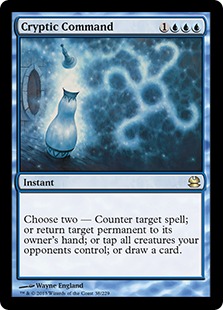 to an optimal list for the current metagame. For those unaware, Gurmag Angler and Tasigur, the Golden Fang provide an incredible amount of play to this strategy that would probably be unplayable without them. Unlike any control deck I’ve played before, Grixis is able to shift roles whenever necessary, be it “turning the corner” against aggressive strategies, or providing quick pressure against combo decks. Opponents are constantly forced to play into our removal and counterspells, while at the same time diluting their deck with answers to our cheap delve creatures. This allows us to generate virtual card advantage while our opponent sits with Path to Exiles and Dismembers in hand instead of threats, while we stock up on removal spells and Cryptic Commands. Eventually, we can deploy our delve creatures when ready, only to recur them with Kolaghan's Command when our opponent does kill them, all while generating value. It is truly sickening.
to an optimal list for the current metagame. For those unaware, Gurmag Angler and Tasigur, the Golden Fang provide an incredible amount of play to this strategy that would probably be unplayable without them. Unlike any control deck I’ve played before, Grixis is able to shift roles whenever necessary, be it “turning the corner” against aggressive strategies, or providing quick pressure against combo decks. Opponents are constantly forced to play into our removal and counterspells, while at the same time diluting their deck with answers to our cheap delve creatures. This allows us to generate virtual card advantage while our opponent sits with Path to Exiles and Dismembers in hand instead of threats, while we stock up on removal spells and Cryptic Commands. Eventually, we can deploy our delve creatures when ready, only to recur them with Kolaghan's Command when our opponent does kill them, all while generating value. It is truly sickening.
Against combo decks like Scapeshift and Living End, Thought Scour functions as a passable Black Lotus, letting us power out six and seven mana delve creatures as early as turn two and three to pressure our opponent while we seek to disrupt their combo with counterspells. Creeping Tar Pit and Lightning Bolt/Snapcaster Mage speed up our clock considerably, and the fetch/shock nature of Modern means we usually only need to do 15-17 damage to kill our opponent. With random damage from Bolt and Kolaghan's Command, we often only need to hit twice with Tasigur or Angler before our opponent is at a life total low enough to finish with burn. This deck, (yes, this control deck) kills on turns 5-7 with a surprising consistency.
Some notes about card choices and play:
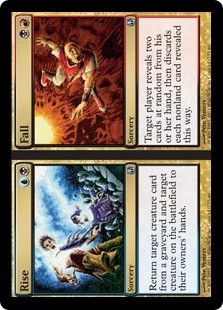 Rise // Fall popped up in a few lists for a couple weeks leading up to the Modern Festival. LSV popularized it on ChannelFireball but the tech has been floating around for weeks. In this list, this card does similar things to Shadow of Doubt; an interesting, unexpected effect that can oftentimes be dead and clunky, but can also just be insane. Rise // Fall can often be used as a supercharged fourth Kolaghan's Command, bouncing a delve creature our opponent has killed and a Snapcaster of our own back to our hand. Even the “worst case” scenario where we have no creature on board can be solved. Bouncing an opposing creature is fine, and I’ve even used it to bounce an on-board Loxodon Smiter and a Noble Hierarch in my opponent’s graveyard to hand in the midgame to buy time. Then, of course, there are the situations where we are casting Hymn to Tourarch in Modern. I don’t think I need to elaborate on why that’s good.
Rise // Fall popped up in a few lists for a couple weeks leading up to the Modern Festival. LSV popularized it on ChannelFireball but the tech has been floating around for weeks. In this list, this card does similar things to Shadow of Doubt; an interesting, unexpected effect that can oftentimes be dead and clunky, but can also just be insane. Rise // Fall can often be used as a supercharged fourth Kolaghan's Command, bouncing a delve creature our opponent has killed and a Snapcaster of our own back to our hand. Even the “worst case” scenario where we have no creature on board can be solved. Bouncing an opposing creature is fine, and I’ve even used it to bounce an on-board Loxodon Smiter and a Noble Hierarch in my opponent’s graveyard to hand in the midgame to buy time. Then, of course, there are the situations where we are casting Hymn to Tourarch in Modern. I don’t think I need to elaborate on why that’s good.
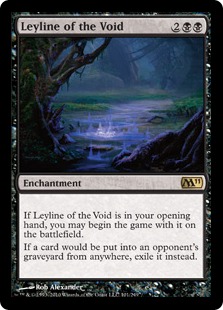 Leyline of the Void was a last minute inclusion right before the Modern Festival Finals. A viewer suggested it in my first Grixis article but it seemed out of place in a metagame full of Affinity and big-mana decks. Now, Grixis decks are everywhere online, as well as Living End, Grishoalbrand, Storm, Dredgevine, and numerous other strategies seeking to use the graveyard for value. The format is also pretty hostile to artifacts because of Kolaghan's Command, and weak to enchantments in general, so Leyline currently has a greater chance than normal of sticking around the battlefield.
Leyline of the Void was a last minute inclusion right before the Modern Festival Finals. A viewer suggested it in my first Grixis article but it seemed out of place in a metagame full of Affinity and big-mana decks. Now, Grixis decks are everywhere online, as well as Living End, Grishoalbrand, Storm, Dredgevine, and numerous other strategies seeking to use the graveyard for value. The format is also pretty hostile to artifacts because of Kolaghan's Command, and weak to enchantments in general, so Leyline currently has a greater chance than normal of sticking around the battlefield.
- Why this over Delver? I’m probably asked this question more than any other on stream (except maybe “why aren’t you partnered
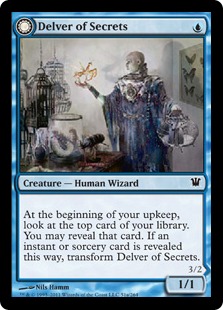 yet”) so I figured I’d answer here in writing. We talked about this a bit in my previous Grixis article, but I will say it again: cutting Delver of Secrets allows us to play a more reactive game and gain points against aggressive strategies like Affinity and Burn. Delver of Secrets pushes us into playing Gitaxian Probe, which wants us to also play Young Pyromancer. This strategy is great, but we end up having to do a little too much damage to ourselves to win a game of Magic, which is not where I want to be against a bunch of aggressive decks. Cutting these cards lets us play a higher land count (not a bad thing, as we gain Creeping Tar Pit), as well as powerful spells such as Cryptic Command and more copies of Kolaghan's Command. In a format full of big mana decks and combo, Delver might be better, but as it is now I like where Grixis Control lines up.
yet”) so I figured I’d answer here in writing. We talked about this a bit in my previous Grixis article, but I will say it again: cutting Delver of Secrets allows us to play a more reactive game and gain points against aggressive strategies like Affinity and Burn. Delver of Secrets pushes us into playing Gitaxian Probe, which wants us to also play Young Pyromancer. This strategy is great, but we end up having to do a little too much damage to ourselves to win a game of Magic, which is not where I want to be against a bunch of aggressive decks. Cutting these cards lets us play a higher land count (not a bad thing, as we gain Creeping Tar Pit), as well as powerful spells such as Cryptic Command and more copies of Kolaghan's Command. In a format full of big mana decks and combo, Delver might be better, but as it is now I like where Grixis Control lines up.
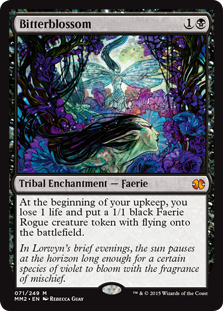 Bitterblossom is still awesome. We can’t afford to play it against Grixis Delver, as they have finally wised up to sticking to their role in the matchup and are no longer boarding out their Delvers. For a while, Grixis Delver players were attempting to play the same game as us and the matchup was a breeze, as we were both playing a control game but they had 18 lands and no Cryptic Commands vs. our “control as Plan A” strategy. As a result, I’ve trimmed down to one copy of Bitterblossom, but could definitely go back to two if Twin and control get popular again.
Bitterblossom is still awesome. We can’t afford to play it against Grixis Delver, as they have finally wised up to sticking to their role in the matchup and are no longer boarding out their Delvers. For a while, Grixis Delver players were attempting to play the same game as us and the matchup was a breeze, as we were both playing a control game but they had 18 lands and no Cryptic Commands vs. our “control as Plan A” strategy. As a result, I’ve trimmed down to one copy of Bitterblossom, but could definitely go back to two if Twin and control get popular again.
The hardest part about this deck, in my opinion, is determining when to expend resources protecting our delve creatures, and when to let them  die. Between 3 Kolaghan's Command and 5 delve creatures, it’s rarely hard to find a second or third copy, which brings up an interesting dilemma when our opponent is struggling to remove our huge creature from the field. On the one hand, Gurmag Angler is often single-handedly holding back Tarmogoyfs and Loxodon Smiters (or killing our opponent) and we would like to keep it around, on the other hand, our resources might be better spent just countering “stuff”. I’ve come to the conclusion that more often than not, it comes down to mana-efficiency and reading the opponent (as best as you can when playing online). If spending resources to protect our creature means that our opponent needs to devote a turn to kill it (by spending more mana on removal instead of threats), or if saving our creature means we make our opponent skip combat for a turn or two it’s probably worth it. The decision trees that Gurmag and Tasigur create are very interesting and definitely worth exploring, as they lead to great lines and fun, close games.
die. Between 3 Kolaghan's Command and 5 delve creatures, it’s rarely hard to find a second or third copy, which brings up an interesting dilemma when our opponent is struggling to remove our huge creature from the field. On the one hand, Gurmag Angler is often single-handedly holding back Tarmogoyfs and Loxodon Smiters (or killing our opponent) and we would like to keep it around, on the other hand, our resources might be better spent just countering “stuff”. I’ve come to the conclusion that more often than not, it comes down to mana-efficiency and reading the opponent (as best as you can when playing online). If spending resources to protect our creature means that our opponent needs to devote a turn to kill it (by spending more mana on removal instead of threats), or if saving our creature means we make our opponent skip combat for a turn or two it’s probably worth it. The decision trees that Gurmag and Tasigur create are very interesting and definitely worth exploring, as they lead to great lines and fun, close games.
Roleshifting in Practice
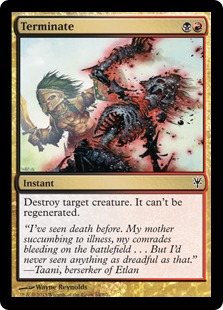 I’ll close on an anecdote; in the Modern Festival finals we played against a Jund deck on stream. Our opponent led with discard into no two-drop creature; a relatively slow start. We were able to land a quick Gurmag Angler and protect it from Liliana of the Veil with a Mana Leak, leaving us with a Spell Snare, Terminate, Terminate #2, and lands in hand against an opponent with a few cards in hand but no board. Our opponent drew for his turn five and passed, letting us get in a Gurmag hit. His next turn he played Scavenging Ooze and passed again, which we answered with Terminate. The turn after he played Tarmogoyf, which we answered with our last Terminate. This raised the question of Terminate vs. Spell Snare on the Tarmogoyf, which I considered interesting enough to discuss.
I’ll close on an anecdote; in the Modern Festival finals we played against a Jund deck on stream. Our opponent led with discard into no two-drop creature; a relatively slow start. We were able to land a quick Gurmag Angler and protect it from Liliana of the Veil with a Mana Leak, leaving us with a Spell Snare, Terminate, Terminate #2, and lands in hand against an opponent with a few cards in hand but no board. Our opponent drew for his turn five and passed, letting us get in a Gurmag hit. His next turn he played Scavenging Ooze and passed again, which we answered with Terminate. The turn after he played Tarmogoyf, which we answered with our last Terminate. This raised the question of Terminate vs. Spell Snare on the Tarmogoyf, which I considered interesting enough to discuss.
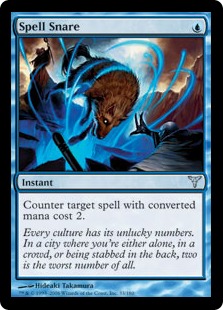 At that point, we were flooding out and had nothing but lands and the Snare/Terminate, while our opponent still had 3-4 cards in hand (all spells, as he was stuck on four lands for a turn or two). It seemed obvious at that point that our opponent had at least Lightning Bolt, and possibly Terminate as well in hand. The Bolt I was almost 100% sure of, as he led with Scavenging Ooze before Tarmogoyf, signaling his intentions to possibly chump and finish off the Gurmag with Bolt. It seemed like he was playing around Leak as well, since he passed on turn five and didn’t play Ooze until hitting his fifth land. This suggested to me that he also had Terminate, which I would need to save my Gurmag from if I had any hope at winning that game (I had no action to my opponents’ multiple cards in hand + Raging Ravine on board). Eventually he went for Terminate on the Gurmag, and I was able to protect it with Spell Snare and win the game. More than anything, this game showed me our deck’s capability to shift roles: without Gurmag Angler to pressure our opponent’s relatively slow draw, we would have just flooded out and died.
At that point, we were flooding out and had nothing but lands and the Snare/Terminate, while our opponent still had 3-4 cards in hand (all spells, as he was stuck on four lands for a turn or two). It seemed obvious at that point that our opponent had at least Lightning Bolt, and possibly Terminate as well in hand. The Bolt I was almost 100% sure of, as he led with Scavenging Ooze before Tarmogoyf, signaling his intentions to possibly chump and finish off the Gurmag with Bolt. It seemed like he was playing around Leak as well, since he passed on turn five and didn’t play Ooze until hitting his fifth land. This suggested to me that he also had Terminate, which I would need to save my Gurmag from if I had any hope at winning that game (I had no action to my opponents’ multiple cards in hand + Raging Ravine on board). Eventually he went for Terminate on the Gurmag, and I was able to protect it with Spell Snare and win the game. More than anything, this game showed me our deck’s capability to shift roles: without Gurmag Angler to pressure our opponent’s relatively slow draw, we would have just flooded out and died.
All in all, I’ve loved playing with my Grixis Control deck this Modern season. I Day 2’d GP Charlotte and went 7-3 in the Modern Festival, losing a weird one to Lantern Control, a match against Tron where my opponent got very lucky, and one match to Affinity where my opponent also got very lucky but I might have had the tools to win. The deck is great, has a ton of play to it and is a lot of fun! What do you think about the deck? Any questions or important interactions you think I missed? What should I write about next week? Let me know!
Trevor Holmes
The_Architect on MTGO
Twitch.tv/Architect_Gaming
Twitter.com/7he4rchitect


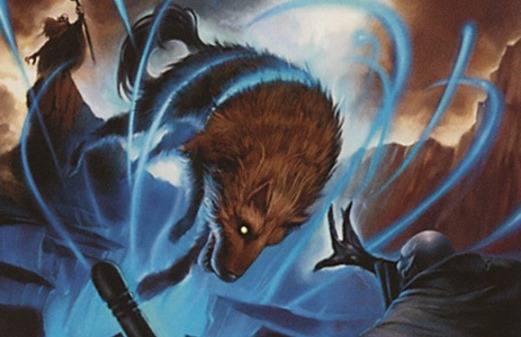
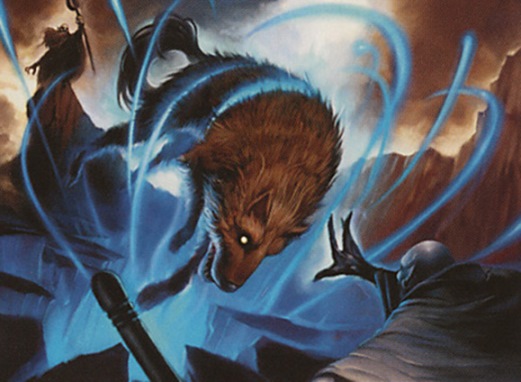


Wow! Thanks for the great article! I’m interested to see the meta on this deck if, IF Day’s Undoing takes hold as some people believe.
Thanks for your take on Grixis Control. I feel that now that the archetype has taken hold, we’re going to see a lot of tweaks going on. The consensus list is far from settled, and I look forward to seeing what people come up with.
Yes. I have problems in transition.
However, I sometimes get too far behind some flying creatures. What would the thought be of tombstalker, the double Black delve creature with flying for 5/5.
Yes, you couldn’t get a turn 2 angler as the double black makes it slower. So, one would still prefer mana efficiency over the flying options to go over the other guys creature for the last 5 points of damage?
Hi, nice article.
I’ve been trying a version of this deck that is more controlling, with no scours, -1 gurmag and more counterspells. Any thoughts on it ?
Thanks,
André.